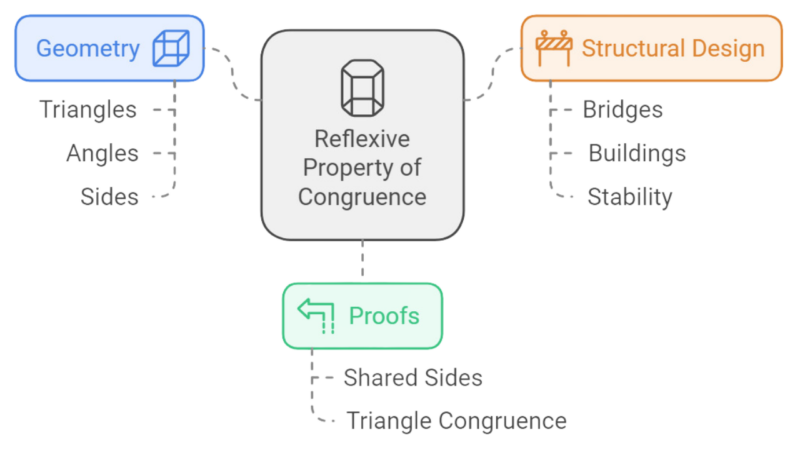
Share Post:
In geometry, congruence refers to the idea that two objects share the same size and shape.
Congruent figures can be overlaid perfectly, meaning every corresponding point aligns exactly.
Whether it’s two triangles, circles, or other shapes, congruence is a foundational concept in proving the relationships between geometric structures.
- Reflexive
- Symmetric
- Transitive
These properties serve as essential tools in mathematical proofs, helping to demonstrate equivalence between geometric figures. Their importance extends beyond theory and into real-world applications.
Table of Contents
ToggleReflexive Property of Congruence

The reflexive property of congruence states that any geometric figure is congruent to itself. This seemingly simple property plays a vital role in geometry.
- Each side of the triangle is congruent to itself.
- Each angle of the triangle is congruent to itself.
The reflexive property is commonly used in proofs involving geometric figures that share a common side or angle.
For example, if two triangles share a side, that shared side is congruent to itself, which allows you to proceed with the proof of congruence between the two triangles.
The reflexive property is particularly useful in the design and construction of structures like bridges or buildings.
- Shared parts are congruent to themselves to ensure stability.
- The same components are structurally congruent across the entire structure.
The reflexive property helps verify that these shared components maintain congruence, ensuring the structural integrity of the project.
Symmetric Property of Congruence

The symmetric property of congruence states that if one geometric figure is congruent to another, then the reverse must also be true.
This property is crucial in geometric proofs as it provides flexibility in comparing figures. By ensuring congruence works both ways, the symmetric property allows for reciprocal congruence, making it easier to establish consistency across different sections of a proof.
In practical applications, the symmetric property is often used in designs that rely on reflective symmetry.
- Many buildings or artworks feature symmetry, where one side mirrors the other.
- Symmetry helps create balance in design, ensuring congruence on both sides of a structure.
By applying the symmetric property of congruence, architects and artists ensure that both halves of a design remain congruent, contributing to structural balance and visual harmony.
Transitive Property of Congruence
The transitive property of congruence, often considered the most complex of the three, states that if two figures are each congruent to a third figure, they must also be congruent to each other.
- If triangle A is congruent to triangle B
- And triangle B is congruent to triangle C
- Then triangle A must also be congruent to triangle C
This property is crucial in geometric proofs where multiple congruences need to be established across various parts of a structure, helping to connect different figures logically.
In real-world applications, the transitive property plays a vital role, especially in engineering and large-scale constructions. When multiple parts of a structure must align perfectly, the transitive property ensures proper congruence between them.
- In bridge construction, several components may need to be congruent to ensure the entire structure holds under stress.
- Using the transitive property, engineers can confirm that if two parts are congruent to a common piece, they are congruent to each other, guaranteeing proper alignment and overall structural strength.
This approach helps maintain consistency and reliability in designs that require precise congruence across interconnected parts.
Importance in Geometric Proofs
The reflexive, symmetric, and transitive properties are foundational to geometric proofs because they help establish equivalence relationships between figures.
- Side-side-side (SSS)
- Side-angle-side (SAS)
- Angle-side-angle (ASA)
By confirming that the corresponding sides and angles of triangles are congruent, these properties support the logical flow of geometric reasoning.
Without these properties, it would be difficult to form the basis of many proofs in geometry, as they provide the structure for understanding how figures relate to one another.
Beyond basic geometric proofs, these properties also help define what is known as equivalence classes in mathematics.
By ensuring that certain elements are congruent, these properties group geometric figures into categories where they can be treated as interchangeable in the context of certain operations.
The categorization is particularly important in higher-level geometry and algebra.
Summary
The reflexive, symmetric, and transitive properties of congruence form the backbone of many geometric proofs.
Their importance extends from simple geometric problems to more complex applications in fields like engineering and design.
These properties provide a logical foundation for establishing relationships between geometric figures, ensuring that congruence is maintained consistently and accurately in both theoretical and practical settings.











